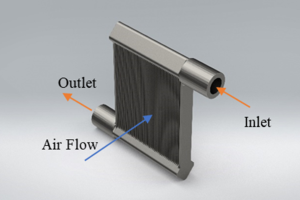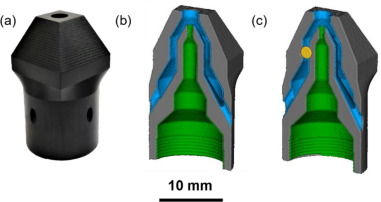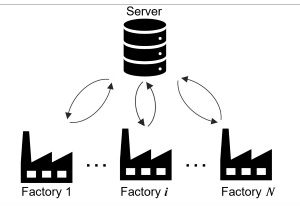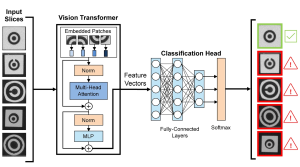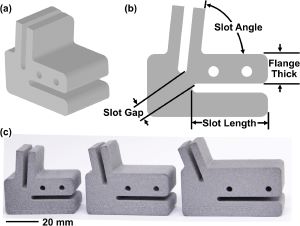Publications
In Review
- Bimrose, M.V., D.J. McGregor, C. Wood, S. Tawfick, and W.P. King. “Additive manufacturing source identification from photographs using deep learning.” Submitted.
Published / Accepted
15. Multi-objective surrogate optimization of process parameters for additive manufacturing with applications in laser powder bed fusion
Proc. ASME IDETC-CIE: Vol. 3A
|
November 2024
We propose an optimization-based approach for selecting additive manufacturing (AM) process parameters for high quality parts made using laser powder bed fusion (LPBF). By optimizing three process parameters (layer thickness, laser power, and scanning speed), we achieved 17% better geometric accuracy while meeting porosity requirements. Our results reveal that laser power is the most influential parameter affecting both geometric accuracy and porosity.
14. Automatic detection of hidden defects and qualification of additively manufactured parts using X-ray computed tomography and computer vision
Manufacturing Letters
|
October 2024
We train machine learning models to identify geometric defects in x-ray computed tomography (CT) scans of additively manufactured (AM) parts. We manufactured 155 nozzle parts, some with various intentional defects, and CT scanned each part. A ResNet34 model successfully identified 98% of defects after training on as few as 30 parts, demonstrating the promise of machine learning to identify AM defects in CT scan data.
13. Federated learning enables privacy-preserving and data-efficient dimension prediction and part qualification across additive manufacturing factories
Journal of Manufacturing Systems
|
June 2024
We use federated learning (FL) to predict additively manufactured part dimensions and qualify parts while preserving data privacy. We develop machine learning models using private data from distributed sources, allowing for collaborative model training without compromising privacy. When tested on 405 manufactured parts from multiple factories, FL models outperform individual learning by up to 96%.
12. Detecting and classifying hidden defects in additively manufactured parts using deep learning and X-ray computed tomography
Journal of Intelligent Manufacturing
|
May 2024
We train a Vision Transformer (ViT) using computer-generated images of defects and successfully identify real defects in x-ray computed tomography scans of real additively manufactured parts. We demonstrate this work using a data set of 227 parts, some having intentional defects. The ViT model trained on over 50,000 images and achieved over 90% testing accuracy, demonstrating the potential of synthetic data to train ML models for defect detection.
Selected Press:
AZO-materials
, NovusLight
11. Geometry repeatability and prediction for personalized medical devices made using multi-jet fusion additive manufacturing
Additive Manufacturing Letters
|
April 2024
This research studies the repeatability of an additively manufactured guide for knee surgery that is personalized to the size and shape of a patient and explores concepts for predicting geometric accuracy. We created 258 unique surgical guide designs with different sizes of the critical features to simulate practical conditions, and manufactured 2100 parts using multi-jet fusion AM.
10. Using machine learning to predict dimensions and qualify diverse part designs across multiple additive machines and materials
Additive Manufacturing
|
July 2022
We developed a data model that describes additive part design information and manufacturing process information using both continuous and categorical variables. A support vector regression (SVR) machine learning model is trained using this data to predict part geometry to within 53 microns. The model is extended to classify the parts as either acceptable or unacceptable with 81% accuracy.
Selected Press:
nanoHub
9. Large batch metrology on internal features of additively manufactured parts using X-ray computed tomography
Journal of Materials Processing Technology
|
April 2022
This study presents an automated method for batch X-ray computed tomography (CT) metrology using open-source software, and investigates 48 nozzle parts made using various additive manufacturing materials and processes. We find that external feature accuracy is not highly correlated with internal feature accuracy. Additionally, part-to-part repeatability for a given material and process is very good.
8. Hierarchical data models improve the accuracy of feature level predictions for additively manufactured parts
Additive Manufacturing
|
January 2022
A Hierarchical Bayesian Linear Model (HBLM) models the effects of multiple additive manufacturing production factors on part geometry. Gaussian process (GP) captures the feature-level spatial variation that can be unique to each part. Together, these models predict part geometry to within 10 microns.
7. Ultra-power-dense heat exchanger development through genetic algorithm design and additive manufacturing
Joule
|
September 2021
We show design automation and additive manufacturing that can achieve high heat transfer with complex 3D structures internal to the heat exchanger that cannot be made with conventional methods. The resulting device achieves a power density and specific power significantly higher than that of most conventional heat exchangers.
Selected Press:
ASME
, 3D-printing-industry
6. Effect of an added mass on the vibration characteristics for raster scanning of a cantilevered optical fiber
ASME J. of Medical Diagnostics
|
May 2021
Piezoelectric tube actuators with cantilevered optical fibers enable the miniaturization of scanning image acquisition techniques for endoscopic implementation. We explore adding a mass at an intermediate location along the length of the fiber to alter the resonant frequencies of the system and enable raster scanning. We provide a mathematical model to predict resonant frequencies for a cantilevered beam with an intermediate mass.
5. Analyzing part accuracy and sources of variability for additively manufactured lattice parts made on multiple printers
Additive Manufacturing
|
April 2021
Framework for analyzing additive manufacturing variability. Statistical modeling analyzes accuracy for hexagonal lattice parts made on multiple printers. Part accuracy varies for different printers even when all other parameters are constant.
Selected Press:
Press Release
4. Emergency ventilator for COVID-19
PLOS ONE
|
December 2020
In response to the need for mechanical ventilators, we designed and tested an emergency ventilator (EV) that can control a patient’s peak inspiratory pressure (PIP) and breathing rate, while keeping a positive end expiratory pressure (PEEP). This article describes the rapid design, prototyping, and testing of the EV. The development process was enabled by rapid design iterations using additive manufacturing (AM). In the initial design phase, iterations between design, AM, and testing enabled a working prototype within one week.
Selected Press:
UIUC RapidVent
3. Automated metrology and geometric analysis of additively manufactured lattice structures
Additive Manufacturing
|
August 2019
Conventional methods for measuring part geometry and performing quality control, which typically use a small number of low-dimensional measurements, are not well suited for the complex structures enabled by additive manufacturing (AM), such as lattice structures. This paper describes a method for scanning and automatically extracting hundreds of individual features and applies this method to characterize AM lattice structures in both two-dimensional and three-dimensional lattices.
2. Mechanical properties of hexagonal lattice structures fabricated using continuous liquid interface production additive manufacturing
Additive Manufacturing
|
January 2019
Recent advancements in AM have enabled rapid production speeds, high spatial resolution, and a variety of engineering polymers. An open question remains whether production grade additive manufacturing (AM) can accurately and repeatably produce lattice parts. This study presents design, production, and mechanical property testing of hexagonal lattice parts manufactured using continuous liquid interface production (CLIP) based AM.
Selected Press:
3Dprint.com
1. Single lens system for forward-viewing navigation and scanning side-viewing optical coherence tomography
Proc. SPIE 10040, Endoscopic Microscopy XII
|
February 2017
The optical design for a dual modality endoscope based on piezo scanning fiber technology is presented including a novel technique to combine forward-viewing navigation and side viewing OCT. Potential applications include navigating body lumens such as the fallopian tube, biliary ducts and cardiovascular system. A custom cover plate provides a rotationally symmetric double reflection of the OCT beam to deviate and focus the OCT beam out the side of the endoscope for cross-sectional imaging of the tubal lumen.
Selected Press:
SPIE
Patents
- King, W.P., S. Tawfick, M. Bimrose, C. Wood, and D.J. McGregor. “Conformance testing of manufactured parts via neural networks.” U.S. Patent No. 12125190, 2024 Oct 22.
Presentations
- Automated metrology enables additive manufacturing process insights and predictions
- Presentation at the ASTM International Conference on Advanced Manufacturing (ICAM), Atlanta, GA, USA. October 2024.
- Automated metrology and geometric evaluation for additive manufacturing
- Invited presentation at the National Academies’ workshop on Statistical and Data-driven Methods for Additive Manufacturing Qualification, Irvine, CA, USA. March 2024.
- Machine learning predicts additive manufacturing part quality: Tutorial on support vector regression
- Invited presentation at nanoHUB (online). August 2022.
- Hands on Python / Jupyter Notebook tutorial using SVR to predict the quality of AM parts
- YouTube recording and Jupyter Notebook
- Large batch metrology on internal features of additively manufactured parts using X-ray computed tomography
- Invited presentation at J. of Materials Processing Technology (online). August 2022.
- Monitoring part quality across multiple printers using automated metrology
- Presentation at the ASTM International Conference on Additive Manufacturing, Anaheim, CA, USA (online). November 2021.
- Factory-level analysis of additively manufactured lattice structures using automated metrology
- Presentation at the ASME International Mechanical Engineering Congress and Exposition, Portland, OR, USA (online). November 2020.
- Mechanical properties of hexagonal lattices fabricated using continuous liquid interface production AM
- Poster at the IUTAM Symposium Architectured Materials Mechanics, Chicago, IL, USA. September 2018.
- Mechanical design and characterization of resonant fiber-optic piezoelectric scanners
- Poster at the AZBio Expo, Phoenix, AZ, USA. March 2017.
- Poster at the Univ. of Arizona Biomedical Engineering Design & Builders Day, Tucson, AZ, USA. March 2017.
- Poster at the Univ. of Arizona Student Showcase, Tucson, AZ, USA. February 2017.
Contact / PDF Access
Copyrights limit what I can share on this website. If you are interested in reading one of my publications but do not have journal access, I am happy to privately share a PDF copy. Send an email with subject line “Paper Request” to davisjmcgregor{at}gmail{dot}com. Feel free to reach out for other reasons as well!


